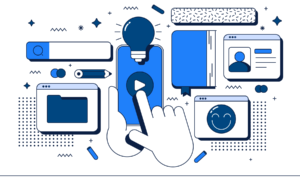QR codes, short for Quick Response codes, are two-dimensional barcodes that can store a large amount of information in a small space. These codes can be scanned using a smartphone camera, and they are commonly used to link to websites, provide contact information, and make payments.
QR codes were first invented in 1994 by a Japanese company called Denso Wave. Initially, QR codes were used in the automotive industry to track inventory and parts. However, as smartphones became more prevalent, QR codes began to be used in a variety of ways, including marketing, advertising, and even in day-to-day life.
How QR codes work?
QR codes work by using a special algorithm to encode information. This algorithm uses a series of black and white squares arranged in a specific pattern to encode the information. The resulting code can be scanned with a smartphone camera, which will then decode the information and take the user to the desired website or provide the desired information.
QR codes can store a variety of information, including website URLs, contact information, and even payment information. When a QR code is scanned, the smartphone camera reads the code and uses an algorithm to decode the information. This information is then displayed on the user’s device, allowing them to quickly access the desired information.
Applications of QR codes
QR codes have a variety of applications, both in marketing and in day-to-day life. Some of the most common applications of QR codes include:
Marketing: QR codes are commonly used in marketing and advertising to provide quick access to information about a product or service. For example, a QR code could be placed on a poster or billboard, allowing users to quickly access a website with more information about the product.
Payment: QR codes can be used to make payments quickly and easily. For example, some stores use QR codes to accept payments from customers, allowing them to scan the code with their smartphone and make a payment without the need for cash or a credit card.
Contact information: QR codes can be used to provide contact information quickly and easily. For example, a business could include a QR code on their business card that links to their website or provides their phone number and email address.
Education: QR codes can be used in education to provide additional information about a topic. For example, a teacher could include a QR code in a textbook that links to a website with more information about the topic being studied.
QR codes can also be used in a variety of other applications, including inventory management, logistics, and even in art installations.
Benefits of using QR codes
QR codes offer several benefits over traditional methods of providing information or making payments. One of the biggest benefits is their convenience. QR codes can be scanned quickly and easily with a smartphone camera, eliminating the need for typing or manually entering information. They also have a high level of accuracy, reducing the risk of errors in data entry.
QR codes are also highly customizable, making them a valuable tool for branding and marketing. QR code generators allow you to customize the design of your QR code with your brand’s logo, colors, and other elements, making them more visually appealing and recognizable.
QR codes are also more secure than traditional methods of providing information. QR codes can be encrypted, making it more difficult for unauthorized users to access the information contained within. This makes QR codes a valuable tool for protecting sensitive information, such as payment information or personal data. Learn more here about QR Codes.
Potential drawbacks of using QR codes
While QR codes offer many benefits, there are also some potential drawbacks to using them. One potential issue is the need for a smartphone with a camera to scan the code. Not all users may have access to a smartphone or may not be comfortable using the technology.
There is also the potential for QR codes to be used maliciously. Scanning a QR code can potentially download malware or other harmful software onto the user’s device. To avoid this, users should only scan codes from trusted sources and be cautious of codes that appear to be suspicious or out of place.
Another potential drawback is the limited space available on a QR code. While QR codes can store a significant amount of information, there is still a limit to how much information can be encoded. This can be a limitation in certain applications where a large amount of information needs to be conveyed.
How to create a QR code?
Creating a QR code is a simple process that can be done using a variety of free online tools. To create a QR code, you will first need to determine what information you want to encode. This could be a website URL, contact information, or any other type of information you want to share.
Once you have determined what information you want to encode, you can use a QR code generator to create the code. There are many free QR code generators available online, such as QRCode Monkey and QR Code Generator. These tools allow you to customize the design of your QR code, including the size, color, and shape.
After generating the code, you can download it and use it in a variety of applications. For example, you could print the code on a business card or brochure, include it in an email signature, or use it on a website or social media platform.
In conclusion, QR codes are a valuable tool for providing quick and easy access to information, making payments, and other applications. While there are some potential drawbacks to using QR codes, the benefits they offer make them a popular choice for businesses and individuals alike. With the use of QR code generators, creating a customized QR code is a simple process that can be done quickly and easily.



















































